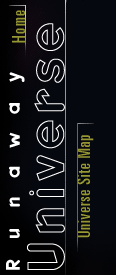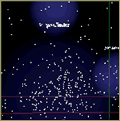 |
 |
 Tour the Universe
Tour the Universe
by Frank Summers
What is your address?
An address is basically a listing of where you live in terms of house, street,
city, state, and country. We can identify each of these places on a map to find
out where we live relative to other places. Knowing some geography, you can
locate anyone in the world using their address.
If you go beyond the basics, your address can continue. We live on the planet
Earth. Earth is one of the planets orbiting a star called the Sun. The Sun is
one of a couple hundred billion stars within the Milky Way Galaxy. But what's
after that? What is beyond planet, star, and galaxy? What is the geography of
the universe?
Apart from astronomy enthusiasts, few people know what comes after galaxies.
And while professional astronomers know the names of the nearby galaxies and
galaxy clusters, most still have a rather sketchy idea of their placement
within the geography of the local universe.
One reason it is hard to learn the geography of the local universe is that it
is 3-D. A map, as a 2-D object, is easy to spread out on a table so you can
learn 2-D relationships between places. For 3-D space, you need to be able to
visualize another dimension. A well-drawn map can provide some feeling of 3-D,
but only as seen from one vantage point. To truly understand the 3-D nature,
you need a 3-D visualization.
We have endeavored to create here a 3-D visualization of the distribution of
nearby galaxies and galaxy clusters. It is a 3-D map, if you will, of the local
universe, with the structures identified and with a grid overlaid, so that
everyone can learn where we live in the universe.
This is just a small part of the universe—less than 1% of the entire
observable universe—but it is our galactic neighborhood. And it is good to
know the geography of your neighborhood.
Background
Galaxies, Clusters, and Superclusters
How is the Universe structured? Find out here.
The Local Universe in 3-D: A VRML Tour
Preparing Yourself and Your Computer for VRML
Where to get the VRML plugin, system requirements,
and how to navigate through a 3-D VRML world.
The Local Universe in 3-D (VRML; 151Kbytes)
Jump right into the tour if your computer already has
a VRML plugin installed.
Non-VRML Version
Zoom-Out Map of the Local Universe
Travel millions of light years away from Earth in this
simple graphic and text version of the tour.
| Frank Summers is an astrophysicist at the Hayden Planetarium, part of the
American Museum of Natural History in New York City. He has worked extensively
on bringing astronomy to the public through the exhibits of the new Rose Center
for Earth and Space. His specialty is creating high-end visualizations directly
from scientific data. His research investigates cosmology and galaxy formation
using supercomputer simulations. For "Runaway Universe," Dr. Summers helped
create some visualization sequences and served as a scientific consultant. |
History of the Universe |
Birth of a Supernova |
Tour the Universe
Moving Targets |
How Big is the Universe? |
Spin a Spiral Galaxy
Resources |
Transcript |
Site Map |
Runaway Universe Home
Editor's Picks |
Previous Sites |
Join Us/E-mail |
TV/Web Schedule
About NOVA |
Teachers |
Site Map |
Shop |
Jobs |
Search |
To print
PBS Online |
NOVA Online |
WGBH
© | Updated November 2000
|
|
|